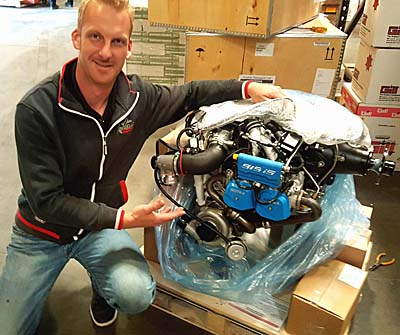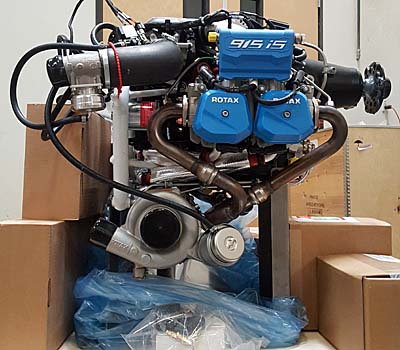As the 2018 flying season launches, a long-awaited powerplant from Rotax Aircraft Engines is beginning to arrive in the USA and to be shipped on to customers for installation.
 Pilots and builders seeking more power can welcome the Rotax 915iS fuel-injected, turbo-charged, intercooler-equipped 135-horsepower engine. Talk about a kick in the pants!
Pilots and builders seeking more power can welcome the Rotax 915iS fuel-injected, turbo-charged, intercooler-equipped 135-horsepower engine. Talk about a kick in the pants!
The engine recently won certification for use on aircraft where such approvals are valuable.
“California Power Systems is proud to announce the first customer delivery of a Rotax 915iS going to Mark and Alina Pringle of Rocky Mountain Kit Planes to install in a Rans S-21 Outbound,” reported Bryan Toepfer, operations manager of CPS, an enterprise related to mail order behemoth, Aircraft Spruce.
“We have another one shipping today for a customer building a Just Aircraft SuperSTOL,” Bryan noted.
He continued, “Two more are on the way from Rotax in Austria to be installed in a couple of gyros.”
According to California Power Systems — a major supplier and service organization for Rotax — customer demand has been high. “We have had many customers excited for this engine,” Bryan explained. “I am very pleased to see this new market evolve for Rotax as well as CPS.”
Flying 915iS
We’ve reported that several airframe manufacturers — “OEMs” in Rotax’s preferred language — have been flying with the newest engine from market-leading Rotax. Enthusiasm for the 915iS is broad. The rollout of this engine was carefully planned by Rotax to ensure good end-customer experiences. As the powerplant has added complexity with the turbo charger and intercooler and carries a higher price tag, good preparation is essential.

Bryan is likewise doing his job as head of operations for CPS. “I was also able to visit the factory in October 2017 to do some training on the new engine.” I am very pleased with the design and performance it offers.”
So keen is his approval that Bryan added, “I am sure within the next few months one of these beautiful wooden crates will be arriving with my name on it.” Can you feel his smile?



Meilleur prix 915iS? (Better price 915iS?)
For pricing, please contact Rotax. (Pour connaître les prix, contactez Rotax.)
Hi. I want to know what kind of turbocharger is use in Rotax 915is, factory’s name, model and more data; please help me.
Hello Shahrokh: For information about Rotax, please follow this link.
Anyone know when FAA certification will be done?
“Certification” is a word for Type Certified aircraft, not LSA or Experimentals. For the latter, no “certification” is needed. For Special (fully built) LSA, the airframe builder and Rotax accomplish “acceptance” by meeting ASTM standards, which they’ve done. Rotax already announced “certification” with EASA (see this article). That usually brings fairly swift approval by FAA using a process called reciprocity.
Hi Dan
The Rotax 915iS has been EASA certified with:
1. a Maximum Take-Off power rating of 141 HP (not 135 HP); and
2. A Maximum Continuous Power (Cruise Power) rating of 135 HP.
Please see your own article!
https://www.bydanjohnson.com/winning-certification-comes-rotax-aircraft-engines-915is
That is the same Maximum Continuous Power rating as a Lycoming IO360 with a Maximum Take-Off power rating of 180 HP and with two thirds the weight.
The Rotax 915iS will also maintain its Maximum Continuous Power rating of 135 HP up to 15,000 feet, whereas the Lycoming IO360 will only do so up to about 7,000 feet.
Many pilots may prefer to cruise at 7,000 feet, however, at 15,000 feet your True Air Speed will be about 15% higher and fuel burn for the trip will be 15% less.
If you consider an aircraft like the SEA Avio Risen, that you reviewed at Aero 2016, that has a cruise speed of 162 Knots at sea-level running a Rotax 912 at 5,050 rpm producing about 75 HP.
With about 134 HP it will cruise at 200 Knots at sea level which will increase to 240 Knots at 10,000 feet and 260 Knots at 15,000 feet. That is 300 mph and faster than many Single Engine Turbo-Props. Not bad for an Ultralight . . . .
Now Thomas Hauklien at Edge Performance is reliably getting 160 HP out of a Rotax 914 with a big bore kit (‘big’ is kind of relative with only 1,417 cc) and EFI which is 8 lbs lighter than the Rotax 914 so even more performance is possible.
By the way, do you know that Alberto Porto flew his SEA Avio Risen from his home in Italy across the Atlantic Ocean to Brazil and then on to Uruguay, where he is from, and back again.
That was a round trip of about 12,000 nautical miles, about 3 times as far as Florida to California and back and rather fewer landing options. Might be worth an article?
Best regards
Philip